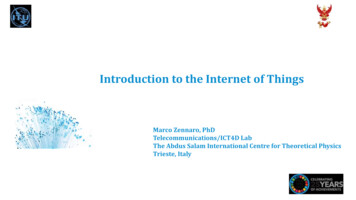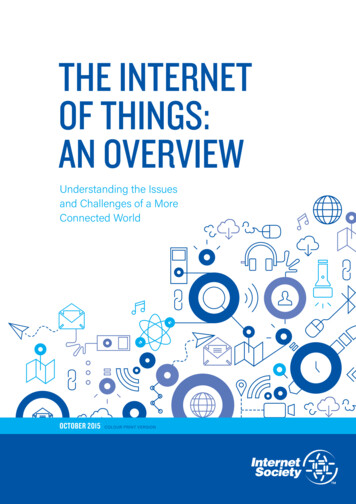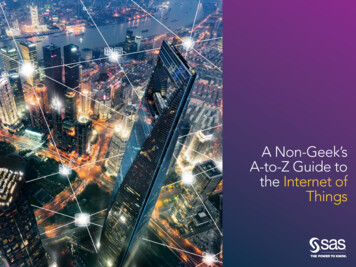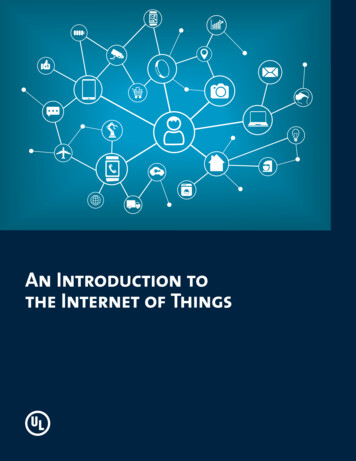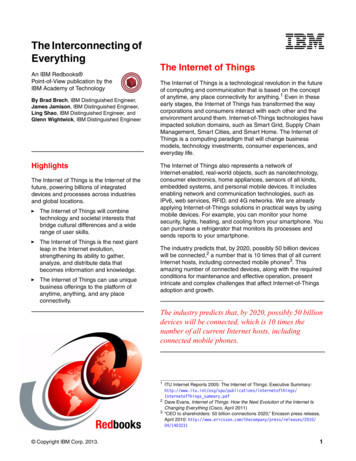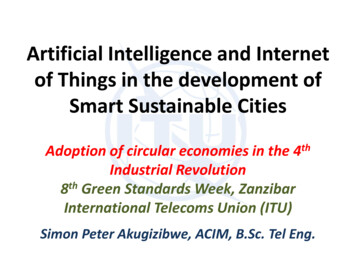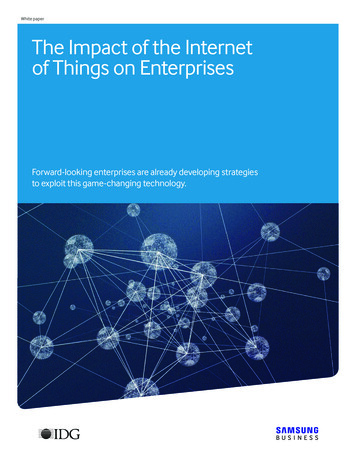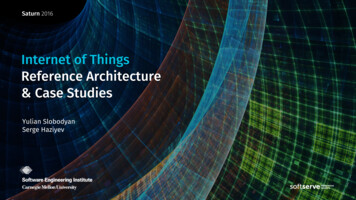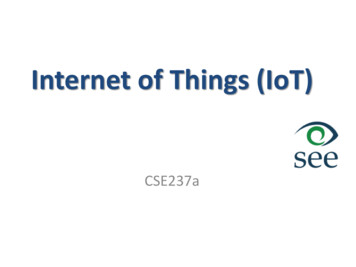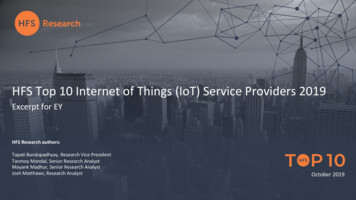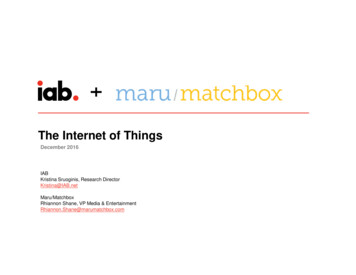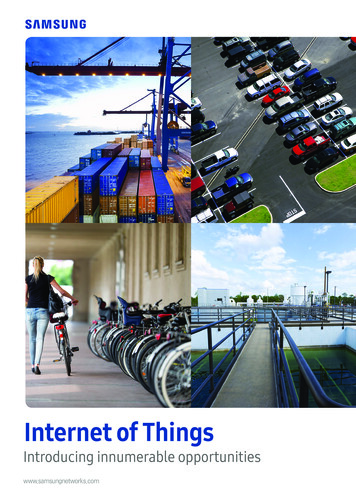
Transcription
Internet of ThingsIntroducing innumerable opportunitieswww.samsungnetworks.com
The Internet of Things (IoT) market is continuously growing as more and more devices are joinedtogether. We are now witnessing an unprecedented increase of information, services, devices andpeople that are dynamically interconnected. The digital interactions are being harmonized into anambient experience that rewrites the traditional definition of being connected.2
Internet of ThingsGlobal IoT market trend and prospectEven as our world today becomes increasingly connected, many industry experts testify to abigger growth of IoT in the future. According to the International Data Corporation (IDC),the IoT market is expected to grow from 655.8 billion in 2014 to 1.7 trillion in 2020.More specifically, this vast market can be broken down to modules/sensors, connectivity,services and other technologies. More than two-thirds of the forecasted market share will bedriven by the first three market segments with modules/sensors ranking first and connectivitycoming in second.1) As such, technologies capable of connecting billions of devices togetherare more important than ever before 1.7 trillionx2.6- Devices(Module/Sensors)- Connectivity- IT Services 655.8 billionMore than60%20202014Communication technologies that empower the IoT world can be divided according tothe distance across which devices need to communicate. Up to now, the majority of IoTbusiness has been focused on short-range communication technologies such as WiFi, Zigbeeand Bluetooth. These technologies can be utilized for stationary objects or at generally shortdistances at scales of tens of hundreds of meters. Smart homes, where stationary homeappliances such as refrigerators, televisions and lighting systems are all situated close to eachother, can be connected with such technologies. Smart offices, where printers, card readersand other devices can be connected, are also an ideal place to implement short-rangeconnectivity.However, the market is now requiring technologies for longer-range communications,particularly with the emergence of demand for connectivity between mobile objects orobjects spread out across a wide area. These objects usually don’t need to transmit highamounts of data and are often used to track the state of an object or its environment.Smart metering for electricity or gas, smart farming, such as checking the soil moisturelevels, and smart tracking of freight are all excellent examples of such applications for IoT.All of these cases require a network where only small amounts of data will be transferredbut spread across a wide area. Such networks are now referred to as Low Power Wide Area(LPWA) networks. Although not as developed as short-range IoT, there are already caseswhere long-range communication for IoT is being used and this trend will continue to growexponentially. Operators are quickly realizing that this is a chance to develop a new sourceof revenue; LPWA network can be utilized by countless consumers as well as across virtuallyany industry imaginable.3
SAMSUNG NETWORKSLPWA & Cellular IoT NetworksThere are several different technologies that an operator can choose to deploy LPWAnetworks. An operator may consider either an evolved version of the current LTE cellularnetwork such as LTE-M and Narrow Band-IoT (NB-IoT) or new IoT technologies such as LoRaand SIGFOX.GbpsShortDistanceMbpsCellularUMTS, HSPA, LTE, LTE AWiFiZigbeekbpsLPWABluetoothLoRa, SigFox, NB-IoT, LTE-Mbps10m100m1Km10KmLPWA technologies all share certain traits that make them uniquely suitable for long distanceand low-power communication. Devices typically have a long battery life with usually over10 years of operation possible depending on traffic and coverage needs. People are usedto charging the batteries of their smartphones or tablets on a daily basis. However, this isimpossible to do for most cellular IoT devices; they are often deployed to areas with noavailable power or in hard-to-reach locations as in the case of gas/electricity/water metering,agricultural monitoring or transportation tracking. If these devices had only a short lifespansuch as today’s consumer LTE devices, people would need to change the batteries of millionsof devices on a regular basis – an unnecessarily costly and time-consuming job.Because devices are spread out in such a wide area and devices can be situated in hardto-reach places such as basements or inside elevators, an enhanced coverage is necessary.Many of the deployed objects may also be moving and therefore broad coverage willalso be needed to ensure uninterrupted coverage. At the same time, devices only need tosend small amounts of data e.g. kilobytes at a time) to relay information about a certainobject and heavier data, such as images or videos, is rarely involved. Therefore, these LPWAtechnologies only need a very small amount of bandwidth and can be deployed efficiently.The cost of the devices themselves is now undergoing a significant decrease. Billions ofdevices are expected to be deployed in our connected future, and it would be virtuallyimpossible to construct an IoT network with expensive devices. In order for mass deploymentto become a reality, the total cost of ownership (TCO) should be very low.4
Internet of ThingsSimilar to LTE, LPWA technologies can be deployed in either licensed or unlicensedspectrum. LoRa and SiGFOX are great examples of LPWA technologies that use unlicensedspectrum. These technologies are developed for the sole purpose of enabling Machine TypeCommunication (MTC) and can connect sensors with ultra-low data transfer requirements.These technologies are available today and are already in-use in many countries, enablingservices such as bicycle tracking.Cellular IoT, evolved from LTE, includes technologies such as LTE-M and NB-IoT. Bothtechnologies have been standardized with NB-IoT being an integral part of the recentlyfinished 3GPP Release 13. They are designed to be operated within spectrum bands – eitherGSM or LTE. LTE-M is readily available today and is a mature solution for MTC. Althoughevolved from LTE, it serves as something of a middle ground between the traditionalcapabilities of LTE networks and the requirements of IoT devices, supporting slightly higherdata rates than existing LPWA technologies. LTE-M supports FDD, TDD and half duplex (HD)modes and can be deployed in any LTE spectrum. It can also coexist with other LTE serviceswithin the same band and only requires a very narrow bandwidth between 1.08 and 1.4MHz,compared to the 5, 10 or 20MHz bandwidth of a normal LTE carrier.Narrowband-IoT, or NB-IoT, is expected to be available in 2016 and is designed to moreclosely match the requirements of LPWA-type networks. Geographical coverage is extendedover that of LTE-M while supported data rates are lower, allowing even longer battery life fordevices and narrower spectrum requirements of 180 to 200 kHz. NB-IoT supports 3 modesof operation in terms of frequency; standalone, guard band, and in-band. The guard bandmode, as the name suggests, utilizes the otherwise unused narrow resource block withinan LTE carrier’s guard band. The in-band mode utilizes resource blocks within a normal LTEcarrier. The standalone mode operates in its own individual block of frequency and may bedeployed either on an LTE band or as part of a formerly used GSM carrier.LPWA (Low Power Wide Area)Cellular IoT (3GPP Standard-based)LTE-MCat 1(Rel.8)Cat 0(Rel.12)Cat MNon-Cellular IoTNB-IoT(Rel.13)LoRaSigFox 14km 17km(Rel.12)Coverage*Same as LTE coverage(Cat-M : Deeper Penetration)SpectrumLTE In-band Only 20dB than LTE( 22km)LTE In-bandGuard bandStandaloneUn-licensed BandSignal BW20 MHz1.4 MHz1.08 MHz180 kHz125 kHz0.1 kHzData Rate10Mbps1Mbps1Mbps200kbps10kbps100bpsBattery Life10years10years10years* Based on 800MHz, Sub-Urban5
SAMSUNG NETWORKSIoT Use Cases in KoreaAs mentioned above, many operators, who are currently focusing on short-range IoT, willalso start investing in the LPWA market as well. Korea represents a perfect example of thistrend. Korea is already an advanced LTE country where mobile subscriptions have reachedsaturation levels. In 2015, individual mobile subscription increased by a mere 1.5%; however,the number of IoT subscriptions increased by 23.4% over the same period.2) Against thisbackdrop, more mobile service providers appear to be focusing their efforts on IoT andseeing that the LPWA market as a driving force and new revenue source for expanding theirbusiness.01Transforming the city into an IoT hub3)The majority of today’s IoT market consists of short-range communications and indoorenvironments, but the market is shifting its focus to long-range for both outdoor andindoor coverage. The Korean government, with one of the mobile carriers in Korea, hasteamed up with Samsung to build an IoT city in Daegu, 300 kilometers southeast of Seouland the nation’s fourth largest city. Daegu is to be designated as a regulation-free zone forinformation and communication technologies (ICT).The government plans to install IoT infrastructure across the entire city, setting up IoTbased infrastructure for renewable energy solutions, cloud platforms and big data analytics6
Internet of Thingsfor healthcare and medical services, as well as infrastructure for autonomous and electricvehicles. Samsung will provide its intellectual property on equipment and IoT-dedicatednetworks throughout the city, while the central government will ease regulations to facilitateIoT-related projects and secure budget, thus providing both administrative and financialsupport. And the Daegu municipal government will strengthen its support for IoT startupvendors and establish an open lab where IoT-specialized tech start-ups can verify theirtechnologies and services.Through the implementation of various solutions, including an IoT-dedicated network,standalone base stations and IoT applications, the Korean government plans to create a newbusiness ecosystem by supporting ventures seeking to both enter the global market and playa key role in developing the nation’s ICT industry. Golden opportunities are waiting to betapped. Some of the major IoT applications in this testbed will include the following.4)Central GovernmentAdministrative & Financial supportTelcosSamsungProvide IoT-dedicatednetwork & equipmentIoT Network ProviderLocal GovernmentEstablish an open lab for Start-upsStart-ups in DaeguExplore & Develop IoT-specialized Service- Utilizing IoT Cloud medical information to develop technologies: Based on global IoT cloud,develop and establish medical information system, develop Artificial Intelligence (A.I) doctorfor early detection of diseases- System establishment and management for infectious diseases: Establish national systemfor efficiently manage infectious diseases; develop home monitoring system and medicalequipment, develop real-time tracking of quarantine patients- Establishing advanced city for future automobiles: Establish charge infrastructure for electric cars.- Energy efficiency & establish renewable energy infrastructure: Build solar energy powerplant for idle sites, parking lots and industrial complex. Replace 60,000 streetlights andsecurity lights to LED.Utilize IoT Cloud medical info. for technology developmentSystem establishment & management for infectious diseasesAdvanced city establishment for future automobilesEnergy efficiency & establish renewable energy infraEstablish IoT Testbed7
SAMSUNG NETWORKS02Connecting industries and lives with LTE-M5)In the near future, things around us, such as bicycles, parking lots, lights, and constructionequipment will be connected and capable of automatically fulfilling our needs and providingimportant information and adjusting our behaviors or business processes.One of the Korean fixed line telecommunications providers has announced that they willincorporate LTE-M into their network and support the Internet of Things (IoT). Moreover, theprovider will explore several new specialized services such as bicycle anti-theft service, smartmetering, smart blood box, smart lighting and more.The telecommunications provider’s latest initiative for deployment of a commercializednationwide IoT network, is based on, and named after, the 3GPP’s LTE-M standard andlargely utilizes the existing LTE infrastructure, but aims to provide a lower data-rate at alower transmission power without impacting existing cellular service. As such, it is an optimalchoice for network operators to support the connectivity requirements for IoT since itoffers an easy software upgrade for existing networks while providing advanced device keyperformance indicators (KPIs), as well as improvements to device battery life and coveragewhile ensuring a low overall total cost.Following the Korean government’s lead, the mobile carrier plans to complete service testingfor its network within the final quarter of this year, providing connectivity for 100,000objects. The operator aims to increase the number of connected modules to 4 millionby 2018. Such networks can lead to clear cost savings in our daily lives and can also beused to save lives. Moreover, the entire global economy will benefit from this standardsbased approach as it stimulates innovation, accelerates cost efficiency and guaranteesinteroperability.Bicycle anti-theft serviceAnti-theft alarm & real-time location trackingSmart meteringElectricity metering, water & gas will be available, LPG tank deterioration, freshness & remaining amount of beer in barrelSmart blood boxSample and blood location tracking, and real-time blood temperature checkSmart container/smart lockIoT-base smart track/lock solution for home, warehouse and customersSmart VehiclePlatform to provide innovative connected-car service based on real-time control and data analysisSmart heavy equipmentSolution for factory & industrial sites to prevent accident, efficient human resource managementSmart lightingTurns on/off stor
Internet of Things for healthcare and medical services, as well as infrastructure for autonomous and electric vehicles. Samsung will provide its intellectual property on equipment and IoT-dedicated networks throughout the city, while the central government will ease regulations to facilitate
